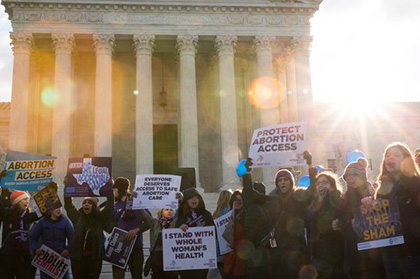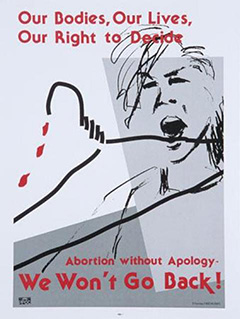
While the requirements were motivated by anti-abortion organizations and politicians, they were justified as supporting women’s welfare. Since the 1973 Roe v. Wade decision established that women have the legal right to control their reproductive lives, the right wing has found that invoking support for women’s health and safety is more effective than emphasizing fetal “rights.” HB2 requires that clinics must meet building specifications as if they were ambulatory surgical centers and its doctors must obtain admitting privileges at local hospitals. These unnecessary rules target only clinics where abortions are performed, not other medical clinics.
The fact is that these clinics have been operating safely under licensing requirements and annual inspections. Texas’ solicitor General, Scott A. Keller, maintained HB2 was necessary for women’s health and cited the statistic that annually 210 women (out of 72,500) suffer complications that required hospitalization. That means there is a complication rate of approximately three-tenths of one percent. Before the new law eliminated a transfer agreement, these women were able to receive the follow up medical attention they needed.
Texas politicians, in passing the bill, hung their hat on the U.S. Supreme Court decision in 1992, Planned Parenthood v. Casey. This decision modified the Roe v. Wade decision by saying that since the state had an interest in unborn life therefore it could take certain steps to protect it, as long as it did not place an “undue burden” on a woman. This decision opened the door to imposing mandated counseling (often with erroneous “facts”), a waiting period, and even banned a late-term procedure. The Casey decision allowed the state to persuade a woman to change her decision, but was not to prevent her from doing so. The right wing ran with that ruling, passing hundreds of laws that did interfere with women’s decisions.
Forty-five amicus briefs by a broad group of organizations and individuals—including leading medical experts, social scientists, legal experts, reproductive rights, and other civil rights advocates—were submitted in opposition to the law. The briefs argued that neither requirement is medically necessary. A dozen reproductive justice organizations highlighted the problems African-American women would face. Nine local and national Latina organizations explained how these restrictions reinforce barriers to Latina women’s healthcare, violating the principle of human rights.
Legal and scientific experts pointed out that the acceptance of these restrictions by the Fifth Circuit’s decision to uphold the law was in error. The Fifth Circuit ruled that as long as “any conceivable rationale” for a regulation exists (even unsupported by data), judges should accept the justification. Therefore the appeals court sharply disagreed with an earlier ruling, when Judge Lee Yeakel of the Federal District Court in Austin said the restrictions created not only an undue burden but “a brutally effective system of abortion regulation.”
Many of the amicus briefs go beyond the issue of abortion to talk about the need for high quality women’s health. Prominent historians argued that the court should carefully scrutinize abortion regulations in the light of a long history of “protecting women” as a pretext to deny them rights. At the one-hour hearing in March, Justice Samuel A. Alito Jr. questioned whether the clinics had demonstrated they would be forced to close if the HB2 law was upheld. But Justice Elena Kagan noted that 12 clinics did shut down when the law went into effect, reopening only when the ambulatory clinic portion of the bill was temporarily blocked. She remarked “it’s almost like the perfect controlled experiment as to the effect of the law, isn’t it?”
Justice Anthony M. Kennedy wondered if the law was upheld would the remaining clinics be able to handle that many abortions. But an even more important question is the one Kagan attempted to discover from a series of questions: What would happen to the 900,000 Texas women who live farther than 150 miles from a provider? Justice Stephen G. Breyer concluded that the consequence would be women dying of complications from self-induced abortions.
Justice Ruth Bader Ginsburg noted that even a woman who took an abortifacient pill early in her pregnancy would have to use an ambulatory surgical center (ASC), commenting “even if a complication arises, it will be after the woman is back home.” Both Justices Sotomayor and Kagan commented that other, more risky procedures, such as dental surgery, liposuctions, and colonoscopies, are safely performed in a doctor’s office. Justice Stephen Breyer flatly remarked that he couldn’t see any basis under which to uphold the restrictions.
If the U.S. Supreme Court were to split in a 4-4 decision, the Fifth Circuit Court ruling that the Texas law was constitutional would stand. They could also opt for putting a decision off to another term or send the case back to the lower court. Given that there seem to be at least four votes to throw out the law, there is the possibility of a 5-3 decision, in which case it would be binding on the 24 other states with similar legislation. However given the presence of at least three anti-abortion judges (Chief Justice John G. Roberts Jr., Judges Clarence Thomas and Alito), it’s unlikely that the court would rule the undue burden standard adopted in 1992 just a ruse.

A 1989 graphic from Prairie Fire Organizing Committee.
Yet it’s way past time to end the use of women’s bodies as a political football. Whenever abortion becomes illegal, some desperate women will choose to risk a self-induced abortion. Women in the 1960s raised the slogan: “Our bodies, our lives, our right to decide.” The state’s job is to help make that dream come true, not block the way.
Ted Cruz, true to form as the most vicious rightwinger in the 2016 presidential race, has exposed his own lie of standing as a “Constitutional conservative.” He’s not content with stripping hundreds of thousands of women of the basic health services that they depend on Planned Parenthood to provide. In itself that’s a standard conservative policy, which of course would result in more—not fewer—abortions. But Cruz goes further, saying that on “Day One” as president he’d “instruct the Justice Department to open a criminal investigation of Planned Parenthood.” No probable cause, just an open-ended witchhunt. That’s neither Constitutional nor conservative; it’s Richard Nixon’s Watergate White House—or perhaps in the context of the 2016 GOP presidential nominating contest, Cruz’s contribution to the remake of “Animal House.”
Dianne Feeley is a member of Solidarity in Detroit, and a retired autoworker.